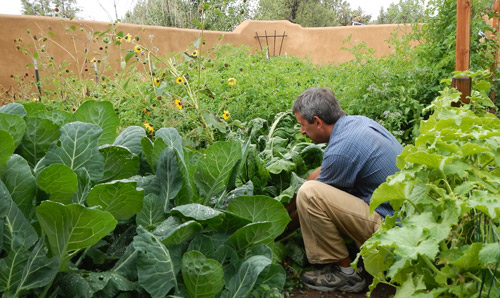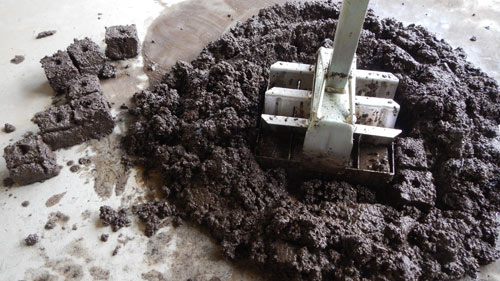Category Archives: Soil Food Web
Best Tools for Spring Gardeners
There are two effective tools I use in the spring for annual bed prep.
One saves my back. The other turbo-charges my seedlings.
And here’s the link for more info on the Broad Fork I use.
Here’s the Link to get in on this spring’s Food Gardener’s Video Workshop!
Seed Catalogs. Here’s how to use them!
This is the time of year people receive their seed catalogs. Many of the choices made here can lead to success or failure in a home food garden. This video will give you a quick overview on how to approach ordering seeds for your organic garden.
It’s the best time of year to sit back and start planning next year’s garden. So we’ve got a GREAT new gardening workshop series coming up. Keep an eye on your email for our new tutorials and a discount on the video training series we will release in the coming weeks!
solar-eclipses
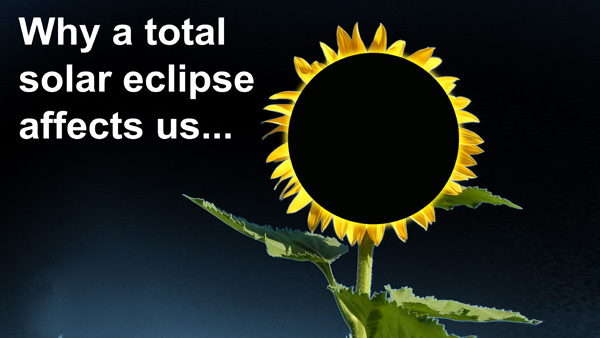
This year’s total solar eclipse got me interested in reading a few accounts of people over the generations who have experienced total eclipses first hand. Most are fun reads. The various descriptions of the observer’s experiences tend to touch on their involuntary emotional responses to watching the sun completely disappear during the day. A common personal reaction is that it can “provoke a flood of primal awe”
For me, that reaction represents the deeper truths that, once felt, cut deeply through our cultural, political outer shells and remind us that we’re all human beings on this planet orbiting around a star. Our shallow differences are moot. There is no them… only us. That realization can be unifying in ways that no amount of conversation or persuasion can match.
It’s interesting to think about how our species has spent millions of years relying solely on the annual photosynthetic energy budget from the sun, first hunting and gathering, then thousands of years using agriculture. That “fresh” sunlight that pulses growth around the planet each year was the only source of energy we knew…until we found fossil fuels (ancient sunlight) and feverously started extracting and burning it in as many ways as possible. Compared to the arc of human existence on this planet, the brief period of explosive growth, sometimes referred to as the fossil fuel “interlude” is an aberration from the old pattern. And one that is harvesting energy from a source too far down the “energy food chain.”
Our food production is so dependent on fossil fuels now that the amount of carbon used per comparative unit of food is a 10-1 ratio. Ten units of fossil fuels to create one unit of food that you can eat. The imbalance in that equation has consequences that we now see in everything from climate change, to synthetic chemicals in our food. We are now containing more of the solar energy in the biosphere than it can process and release, as it has for eons.
Luckily, food-growing techniques that align with natural systems, with no purchased inputs, are alive and well. We can feed ourselves without fossil fuels. But we need to change our general behavior first.
What we need is to re-connect with how this planet works, and mimic that. It’s in understanding those relationships where we find our path forward.
“The Major Problems in the World are the result of the difference between
how nature works and the way people think.”
-Gregory Bateson
I see this connection in my home gardens every year. The solar pulse and the food it generates, not to mention the processing of CO2, and a net sequestration of carbon back into the soil — the opposite of industrial ag.
You don’t need an eclipse to remind you how the planet works. But it does force you to pay attention. It reminds us we’re all alive in this moment and we all have a part to play.
The sense of awe and connection to greater natural systems is what drew me to create the project at GrowFoodWell.com in the first place. And continues to inspire me. I’m in awe each year when I see natural systems that respond to anyone that orchestrates the relationships of microorganisms in the soil through plants and how their dance is timed to track the sun’s movement across the sky.
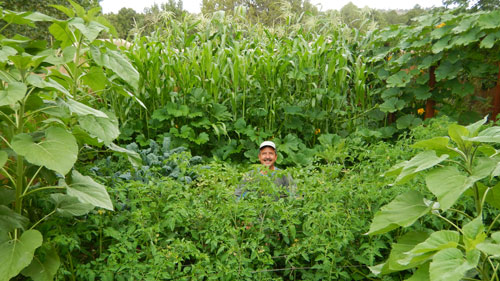
You just need to learn how to be a conductor in the symphony of plants to unlock that pattern.
No “them”. Only “us”
I hope you can relate because we’re all spinning through space together on the same boat.
Enjoy the ride.
Tom
Growfoodwell.com
*(watch the planet “breathe” with the solar calendar in NASA video below)
Compost-Powered Water Heater
Earth Day reminds me – I stand for what I stand on
Earth Day
What that means to me has changed over time.
We all kind of make a collective nod to the planet once a year for all of its supporting services.
And then we return to business as usual.
But over the past few decades I’ve been immersed in projects in the realm of
environmental education, which has given me a deep understanding of the
scale of the challenges in opposition to our preference that “everything will be OK”.
For the past few years I’ve been much more involved in teaching people how to
grow food at home. It has forced me to distill the various layers in that process.
And a couple things stand out.
1) Our collective future is dependent on coming to grips with the fact that the eco-services the biosphere provides are critical for basic survival, and that those systems are under incredible stress right now.
2) The more we align with how natural systems work, the better off we are in this journey.
3) When it comes to healthier food production, water conservation, reduction of CO2 in the atmosphere, and a host of important goals, healthy soil is the baseline necessity to get there.
Soil, — dirt — the ground — Earth.
For all the great accomplishments of humankind,
we owe it all to 6 inches of topsoil and the fact that it rains.
There is a universe of microorganisms in the soil, much like in our bodies, that science is still just beginning to understand. But we know that the more we support the conditions that allow it to thrive, the better things grow in it. A big part of the future of humans will be involve the regenerative quality of soil.
Growing food on a personal scale is one of the oldest of human habits. We’ve done it for over 10,000 years.
Now, more than ever, we can re-connect with the patterns of the natural world by nurturing our patches of soil at home. Even though that in itself will not change everything, it is a personally accessible action that has meaning and leads to a healthier individual, and collectively, healthier communities.
I have interwoven the pattern of food production into my life for the past 16 years. I’ve become respectful of what’s required of me to align with the annual cycles of growing in rich living soil. It has made me appreciate how the small microcosm of a food garden done well models the same answers we are all seeking in the wider arena.
When we align with the systems that have been here for billions of years, we are all better off.
Happy Earth Day.
Dirt First!
Tom Bartels
GrowFoodWell.com
P.S.
I’m just finishing the new workshop on organic compost. It should be ready next week at some point. I’ll send you a note when i get it uploaded.
Cheers
How to make soil blocks
Well, it’s that time of year again. The snow is gone, the weeds aren’t here yet, but the seed orders came through and now it’s time to get the soil blocks going. If you have never tried soil blocks, there are several reasons why you should.
- They save on plastic and trash
- They provide seedlings with more strength before transplant
- They don’t dry out as fast as the cel trays = less stress to the plants
- They avoid the root bound situations you get with cel trays
- They can be transplanted without disrupting root growth
So lets look at a bit of the process:
First I get my seedling trays cleaned and ready (I have re-used most of these for several years
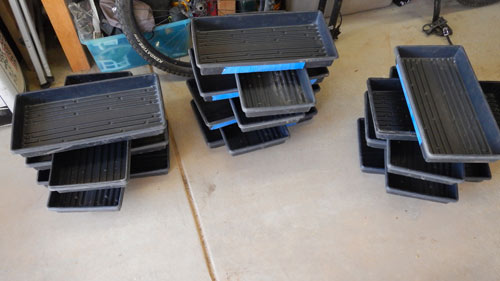 Then I mix the magic recipe (linked below this post)
Then I mix the magic recipe (linked below this post)
Then I get the 12-block “Soil Blocker” out and get ready to rock.
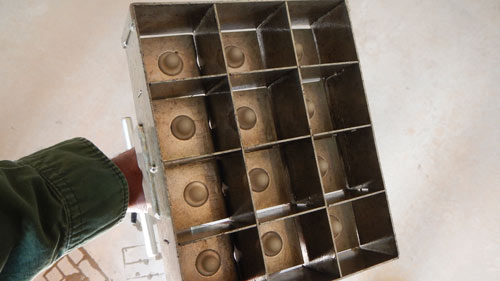 The biggest mistake on the consistency of the soil mix is to have it too dry. So be sure to keep it tacky. Try some experimentation to see how much the blocks compress before doing final ones. The soil mix should be piled about twice the depth of the actual blocks to it compresses as you push it down, then when you release them into the trays they will have the stability you need.
The biggest mistake on the consistency of the soil mix is to have it too dry. So be sure to keep it tacky. Try some experimentation to see how much the blocks compress before doing final ones. The soil mix should be piled about twice the depth of the actual blocks to it compresses as you push it down, then when you release them into the trays they will have the stability you need.
The recipe below makes about 400 blocks. Since I live in Colorado, and our season is about 110 days or so, I need to use these to get a head start on warm season veggies that will endure transplanting later on, especially tomatoes!
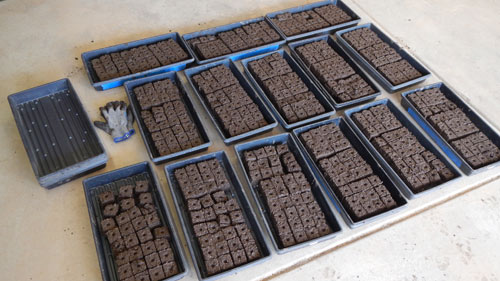 Seeds get planted in each center hole in the blocks. Then during watering this spring you just fill the base of the tray with about a quarter inch of water and the blocks absorb it. The roots will grow to the edge of each block and stop when they hit the oxygen space between them, thereby reducing root binding that is so often the case in cel trays. Once planted, the roots grow right through the block perimeter into the surrounding soil. This accelerates their growth cycle once planted out in the garden.
Seeds get planted in each center hole in the blocks. Then during watering this spring you just fill the base of the tray with about a quarter inch of water and the blocks absorb it. The roots will grow to the edge of each block and stop when they hit the oxygen space between them, thereby reducing root binding that is so often the case in cel trays. Once planted, the roots grow right through the block perimeter into the surrounding soil. This accelerates their growth cycle once planted out in the garden.
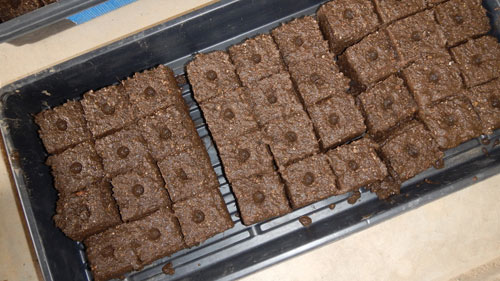
Once the seeds are planted, I cover the hole with some perlite which locks the smaller seeds in place.
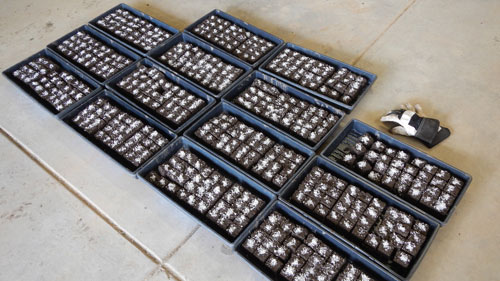
Then they all go inside for germination on the warm tile floor. This can take up to five days depending on the varieties. I cover them with plastic to hold the moisture.
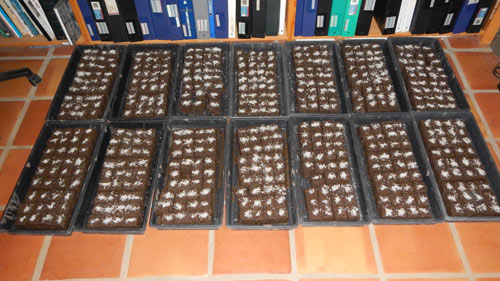 Once most of them germinate they will go into the garage under the timed lights for about 4-6 weeks. By then things will be ready to plant outside.
Once most of them germinate they will go into the garage under the timed lights for about 4-6 weeks. By then things will be ready to plant outside.
Soil Block mix:
(Makes roughly 400 blocks and you can get 36 to a standard tray.)
Mix in wheelbarrow: (Use 5 gal. buckets)
1.5 (5 gal) buckets sifted peat moss / screened through ½ inch hardware cloth
1 (5 gal) bucket course perlite
½ bucket sifted garden soil (screened through ½ inch)
1 (5 gal) bucket sifted (plant based) compost (screened through ½ inch)
1/2 cup lime. Mix
3 cups base Fertilizer (see below) Mix
~1-1.5 bucket water: This mix will be pretty wet when finished right. Biggest mistake is to make blocks too dry.
Organic base fertilizer mix:
(equal parts) roughly one cup each for this batch.
Greensand (for potassium and micronutrients)
Phosphate rock (for phosphorus)
Cottonseed meal or alfalfa meal (for nitrogen)
(Sifted is best on all three)
Use yogurt container as main unit to mix equal parts of above three.
Maybe start with 1/3 container of each ingredient and mix.
(then portion out the 3 cups for above mix)
* When pressing soil, pile needs to be twice the height of the press
* Dip block presser into bucket of water each time to ease the release
* Put tray liner in bottom to help with ease of getting out later
* Move blocks with pallet knife or spatula
* When you plant seed in blocks, put seed in depression and cover hole with Perlite.
Cover trays with plastic after planting seeds to hold moisture. Allow oxygen from below or side. Will sprout in about 5 days
Later when sprouted, pull plastic off and water daily.
Here are links to Soil Blockers. I use the 12 block version but they are made in all kinds of sizes.
**If you are looking for more guidance on all kinds of Organic Gardening Methods, check out Garden Club for a great way to learn!

